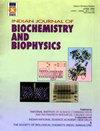TRPM7阳离子通道在神经元缺氧模型中的调节作用
IF 1.5
4区 生物学
Q4 BIOCHEMISTRY & MOLECULAR BIOLOGY
引用次数: 0
摘要
低水平的氧气对细胞有有害的影响,特别是在神经元中,因为它们对氧气消耗的脆弱状态。细胞内钙浓度([Ca2+]i)是通过几种钙渗透通道积累的,包括瞬态受体电位(TRP)通道。TRPM7阳离子通道是钙离子(Ca2+)可渗透的非选择性阳离子通道,属于TRP超家族。TRPM7在人体不同器官中表达,包括神经系统成分,特别是在大脑中。一些TRP通道亚型与氧化应激有关,氧化应激增加会触发通道活性。最近,TRPM7阳离子通道参与了缺氧。因此,[Ca2+]i的改变可能是缺氧时intrpm7活性的关键因素,防止神经元缺氧损伤TRPM7可能是一个治疗靶点。因此,我们研究了siRNA应用下调TRPM7阳离子通道诱导TRPM7活性降低的作用。本研究探讨了TRPM7阳离子通道沉默对SH-SY5Y神经元细胞凋亡和细胞形态、细胞内活性氧(iROS)产生、线粒体膜去极化(MMD)水平、caspase 3、8和9酶活性值的影响。研究表明,下调TRPM7阳离子通道可预防化学缺氧诱导后神经元细胞死亡,保护细胞形态和活力。降低TRPM7通道活性也可能降低钙超载,这是TRPM7通道在缺氧条件下的关键调节功能。综上所述,TRPM7阳离子通道拮抗剂或通过基因操作抑制该通道的表达可能是一种有用且潜在的治疗神经元缺氧相关细胞死亡的方法。本文章由计算机程序翻译,如有差异,请以英文原文为准。
Regulatory role of TRPM7 cation channels on neuronal hypoxia model
Low levels of oxygen have harmful effects on cells especially in neurons because of their vulnerable status for oxygen consumption. Intracellular calcium concentration ([Ca2+]i) is accumulated by several kinds of calcium-permeable channels including the Transient Receptor Potential (TRP) channels. The TRPM7 cation channels are calcium ion (Ca2+) permeable non-selective cation channels belonging to TRP superfamily. The TRPM7 is expressed in different organs of the human body including nervous system components especially in the brain. Some of the TRP channel subtypes are related to oxidative stress and increased oxidative stress triggers channel activity. Recently, TRPM7 cation channels involved in hypoxia. Hence, alterations of [Ca2+]i may be a key factor inTRPM7activity in hypoxia and preventing hypoxic injury of neurons TRPM7 could be a therapeutic target. Therefore, it has been investigated effects of downregulation of TRPM7 cation channels by siRNA applications to induce getting TRPM7 activity down. The role of silencing of TRPM7 cation channels on apoptosis and cell morphology, production of intracellular reactive oxygen species (iROS), mitochondrial membrane depolarization (MMD) levels, enzymatic activity values of caspase 3, 8 and 9 in SH-SY5Y neuronal cells investigated in this study. It has been shown that the downregulation of TRPM7 cation channels may prevent cell death and protect cellular morphology and viability in neuronal cells after chemical hypoxia induction. Decreasing TRPM7 channel activity may also decrease calcium overload and it is a key regulatory function of TRPM7 channels in hypoxic conditions. In conclusion, TRPM7 cation channel antagonists or suppression of the channel expression by genetic manipulations can be a useful and potential therapeutic approach against neuronal hypoxia-related cell death.
求助全文
通过发布文献求助,成功后即可免费获取论文全文。
去求助
来源期刊

Indian journal of biochemistry & biophysics
生物-生化与分子生物学
CiteScore
2.90
自引率
50.00%
发文量
88
审稿时长
3 months
期刊介绍:
Started in 1964, this journal publishes original research articles in the following areas: structure-function relationships of biomolecules; biomolecular recognition, protein-protein and protein-DNA interactions; gene-cloning, genetic engineering, genome analysis, gene targeting, gene expression, vectors, gene therapy; drug targeting, drug design; molecular basis of genetic diseases; conformational studies, computer simulation, novel DNA structures and their biological implications, protein folding; enzymes structure, catalytic mechanisms, regulation; membrane biochemistry, transport, ion channels, signal transduction, cell-cell communication, glycobiology; receptors, antigen-antibody binding, neurochemistry, ageing, apoptosis, cell cycle control; hormones, growth factors; oncogenes, host-virus interactions, viral assembly and structure; intermediary metabolism, molecular basis of disease processes, vitamins, coenzymes, carrier proteins, toxicology; plant and microbial biochemistry; surface forces, micelles and microemulsions, colloids, electrical phenomena, etc. in biological systems. Solicited peer reviewed articles on contemporary Themes and Methods in Biochemistry and Biophysics form an important feature of IJBB.
Review articles on a current topic in the above fields are also considered. They must dwell more on research work done during the last couple of years in the field and authors should integrate their own work with that of others with acumen and authenticity, mere compilation of references by a third party is discouraged. While IJBB strongly promotes innovative novel research works for publication as full length papers, it also considers research data emanating from limited objectives, and extension of ongoing experimental works as ‘Notes’. IJBB follows “Double Blind Review process” where author names, affiliations and other correspondence details are removed to ensure fare evaluation. At the same time, reviewer names are not disclosed to authors.
 求助内容:
求助内容: 应助结果提醒方式:
应助结果提醒方式:


